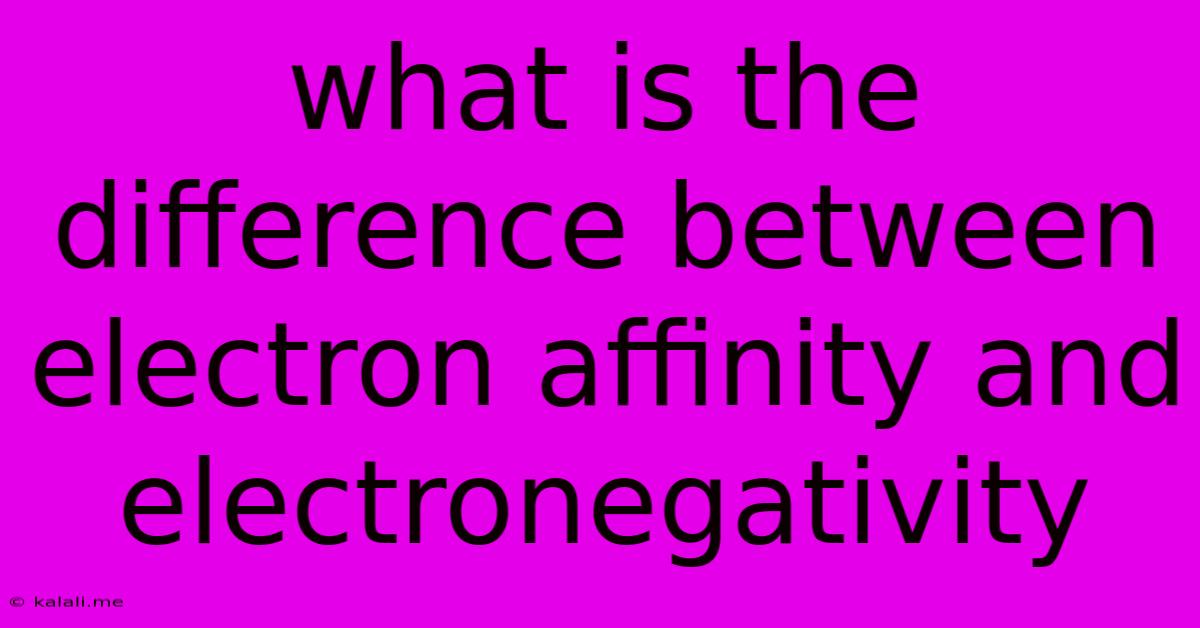What Is The Difference Between Electron Affinity And Electronegativity
Kalali
Jun 16, 2025 · 3 min read

Table of Contents
What's the Difference Between Electron Affinity and Electronegativity?
Understanding the difference between electron affinity and electronegativity is crucial for grasping fundamental chemical concepts. While both relate to an atom's attraction for electrons, they represent distinct properties measured under different circumstances. This article clarifies the distinctions between these two important chemical concepts. This will help you understand the nuances and avoid common misconceptions.
Electron Affinity: A Single Atom's Perspective
Electron affinity measures the energy change when a neutral atom in the gaseous phase gains an electron. It's a measure of how much an isolated atom "wants" to accept an extra electron. A high electron affinity indicates that the atom readily accepts an electron and releases a significant amount of energy in the process (an exothermic reaction). A low or even negative electron affinity suggests the atom is less likely to accept an electron, and may even require energy input (an endothermic reaction). Think of it as the atom's individual preference for gaining an electron in isolation.
Key characteristics of Electron Affinity:
- Focus: A single, isolated atom.
- Process: The addition of a single electron to a neutral gaseous atom.
- Measurement: Energy change (released or absorbed).
- Units: kJ/mol or eV.
- Example: Chlorine has a high electron affinity, readily accepting an electron to form a stable chloride ion.
Electronegativity: A Comparative Measure within a Bond
Electronegativity, on the other hand, is a measure of an atom's ability to attract shared electrons in a chemical bond. It's a comparative property that describes how strongly an atom pulls electrons towards itself when bonded to another atom. Unlike electron affinity, electronegativity isn't measured directly; it's a relative scale. The most common scale is the Pauling scale, with fluorine assigned the highest value (4.0).
Key characteristics of Electronegativity:
- Focus: Atoms within a chemical bond.
- Process: Attraction of shared electrons within a bond.
- Measurement: Relative scale (e.g., Pauling scale).
- Units: dimensionless.
- Example: Oxygen is more electronegative than carbon, meaning in a C-O bond, the electrons are more likely to be found closer to the oxygen atom. This leads to polar bonds.
Summarizing the Key Differences
Here's a table summarizing the core distinctions between electron affinity and electronegativity:
| Feature | Electron Affinity | Electronegativity |
|---|---|---|
| Focus | Isolated atom | Atom within a chemical bond |
| Process | Gaining a single electron | Attraction of shared electrons |
| Measurement | Energy change (kJ/mol or eV) | Relative scale (e.g., Pauling scale) |
| Units | kJ/mol or eV | Dimensionless |
| Context | Describes an atom's tendency to accept electrons | Describes an atom's ability to attract electrons in a bond |
The Interplay and Exceptions
While distinct, electron affinity and electronegativity are related. Atoms with high electron affinities generally exhibit high electronegativities. However, this isn't always a strict correlation. Factors like the atom's size and electron configuration also influence electronegativity.
In conclusion, understanding both electron affinity and electronegativity is essential for a comprehensive understanding of chemical bonding, reactivity, and molecular properties. Remembering the key differences outlined above will help clarify these crucial concepts.
Latest Posts
Latest Posts
-
Displacement Thickness In Boundary Layer Formula
Jun 16, 2025
-
A Circuit Breaker In Which The Interruption Occurs In Air
Jun 16, 2025
-
Lcm Of 3 6 And 2
Jun 16, 2025
-
Fire Extinguisher Questions And Answers Pdf
Jun 16, 2025
-
Which Are Statements That Are True About Ecosystems
Jun 16, 2025
Related Post
Thank you for visiting our website which covers about What Is The Difference Between Electron Affinity And Electronegativity . We hope the information provided has been useful to you. Feel free to contact us if you have any questions or need further assistance. See you next time and don't miss to bookmark.